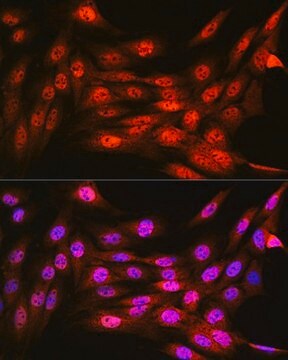PLA0172
Rabbit anti-PML Antibody, Affinity Purified
Powered by Bethyl Laboratories, Inc.
别名:
MYL, PML/RARA fusion, PP8675, RING finger protein 71, RNF71, TRIM19, inducer of, probable transcription factor PML, promyelocytic leukemia, promyelocytic leukemia protein, tripartite motif protein TRIM19, tripartite motif-containing protein 19
登录查看公司和协议定价
所有图片(3)
About This Item
分類程式碼代碼:
12352203
NACRES:
NA.41
推荐产品
生物源
rabbit
品質等級
抗體表格
affinity purified immunoglobulin
抗體產品種類
primary antibodies
等級
Powered by Bethyl Laboratories, Inc.
物種活性
human
技術
immunohistochemistry: 1:200- 1:1,000
immunoprecipitation (IP): 2-5 μg/mg
western blot: 1:2,000- 1:10,000
登錄號
NP_150241.2
UniProt登錄號
運輸包裝
wet ice
儲存溫度
2-8°C
目標翻譯後修改
unmodified
基因資訊
rabbit ... PML(5371)
免疫原
The epitope recognized by PLA0172 maps to a region between residue 375 and 425 of promyelocytic leukemia using the numbering given in entry NP_150241.2 (GeneID 5371).
外觀
Tris-buffered Saline containing 0.1% BSA containing 0.09% Sodium Azide
其他說明
PML is a member of RBCC/TRIM family of proteins that possess a RING finger domain, B-box, and coiled-coil domain. PML is a multifunctional protein involved in activities such as tumor growth suppression, hematopoietic differentiation, gene transcription, apoptotic induction, and viral immunity. PML is often involved in chromosomal translocations with the retinoic acid receptor alpha gene. PML-retinoic acid receptor translocations are associated with acute promyelocytic leukemia.
免責聲明
Unless otherwise stated in our catalog or other company documentation accompanying the product(s), our products are intended for research use only and are not to be used for any other purpose, which includes but is not limited to, unauthorized commercial uses, in vitro diagnostic uses, ex vivo or in vivo therapeutic uses or any type of consumption or application to humans or animals.
Not finding the right product?
Try our 产品选型工具.
儲存類別代碼
12 - Non Combustible Liquids
水污染物質分類(WGK)
WGK 1
閃點(°F)
Not applicable
閃點(°C)
Not applicable
Interplay between PML NBs and HIRA for H3.3 dynamics following type I interferon stimulus.
Kleijwegt, et al.
eLife, 12 (2023)
我们的科学家团队拥有各种研究领域经验,包括生命科学、材料科学、化学合成、色谱、分析及许多其他领域.
联系技术服务部门








